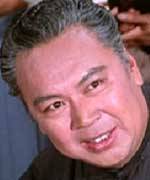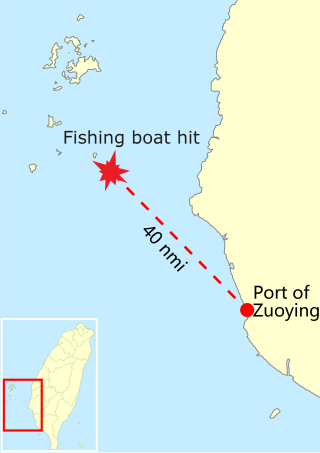Shanghai Theatre Academy is a public university in Shanghai, People's Republic of China dedicated to dramatic art education. Its predecessor was Shanghai Municipal Experimental Theatre School cofounded by the famous educator Gu Yuxiu. Its alumni include actresses Pan Hong, Li Bingbing, Xing Fei, Fan Bingbing, Li Qin, Dilraba Dilmurat, Ma Yili, Xiao Song Jia, Wan Qian and Zhang Yuqi, and actors Tong Dawei, Lu Yi, and Deng Lun.

The Republic of China Navy (ROCN; Chinese: 中華民國海軍; pinyin: Zhōnghuá Mínguó Hǎijūn), also called the ROC Navy and colloquially the Taiwan Navy, is the maritime branch of the Republic of China Armed Forces (ROCAF).

Lo Wei was a Hong Kong film director and film actor best known for launching the martial arts film careers of both Bruce Lee, in The Big Boss and Fist of Fury, and Jackie Chan, in New Fist of Fury.

The Beiyang Fleet was one of the four modernized Chinese navies in the late Qing dynasty. Among the four, the Beiyang Fleet was particularly sponsored by Li Hongzhang, one of the most trusted vassals of Empress Dowager Cixi and the principal patron of the "self-strengthening movement" in northern China in his capacity as the Viceroy of Zhili and the Minister of Beiyang Commerce (北洋通商大臣). Due to Li's influence in the imperial court, the Beiyang Fleet garnered much greater resources than the other Chinese fleets and soon became the dominant navy in Asia before the onset of the 1894–1895 First Sino-Japanese War. It was the largest fleet in Asia and the 8th in the world during the late 1880s in terms of tonnage.

Royal Tramp is a 2008 Chinese television series adapted from Louis Cha's novel The Deer and the Cauldron. Produced by Zhang Jizhong and Huayi Brothers, the series consists of 50 episodes, filmed in high definition. The series was first broadcast on Jiangsu TV in China in 2008 and was subsequently aired on TVB in Hong Kong and other countries.

Letter 1949 is a 2008 Taiwanese drama starring Queenie Tai, Lin Yo-wei, Alien Huang, Hawick Lau. It was produced by Eastern Shine Production. The series was broadcast on free-to-air Chinese Television System (CTS) from 9 to 26 November 2008, Monday to Thursday at 20:00.

Justice Bao is a Chinese TV series starring producer Jin Chao-chun as the Song dynasty official Bao Zheng. The series ran for 3 seasons from 2010 to 2012. In addition to Jin, Kenny Ho, Fan Hung-hsuan and Lung Lung again reprise their iconic roles from the 1993 Taiwanese hit Justice Pao and the 2008 Chinese series Justice Bao.

The 1987 Lieyu massacre occurred on 7 March 1987, at Donggang Bay, Lieyu Island, Kinmen, Fujian, Republic of China. ROC military officially denied the massacre, and defined it as an incident of “mistaken killings” (誤殺事件), hence named as the March 7 Incident (三七事件) or Donggang Incident (東崗事件). There may have been more than nineteen deaths, including several families of ethnical Chinese Vietnamese.
The Eloquent Ji Xiaolan is a Chinese television series about the life of Ji Xiaolan. The series was directed by Zhang Guoli and consists of a total of 173 episodes shot in high definition, each 45 minutes long and containing 10 minutes of 3-D effects. The series is based on events during the reign of the Qianlong Emperor in the Qing dynasty.

The Seven Heroes and Five Gallants is a 1994 Taiwanese television series produced by Chinese Television System (CTS) a few months after its prequel Justice Pao, which was also produced by Chao Ta-shen. Dozens of actors appeared in both series, but only Sze Yu and Tu Man-sheng reprised their roles. Fan Hung-hsuan and Lung Lung chose to portray new characters rather than their iconic roles.

Big Red Riding Hood is a 2013 Taiwanese idol romantic-comedy television series. Produced by Sanlih E-Television and Dreamland Productions, it stars Cheryl Yang as the female main lead and Yao Yuan Hao as the male lead. The series first aired on February 28, 2013 on TTV after Love Me or Leave Me series.

On 1 July 2016, a Hsiung Feng III missile was accidentally launched from a Republic of China Navy vessel from waters off Kaohsiung towards Penghu. The missile hit a fishing boat at 8:40 a.m., killing one person and injuring three.

All in 700 is a 2016 Taiwanese television series starring Darren Chiu, Jessie Chang, Ikeya Chen, Lung Shao-hua, Jason King and Ting Chiang. Filming began on June 24, 2015 and wrapped up on June 8, 2016. First original broadcast began on November 23, 2016 on TTV airing every weekdays night at 8:00-9:00 pm.

Mao Zedong 1949 is a 2019 Chinese historical film directed by Huang Jianxin and Ning Haiqiang. The film stars Tang Guoqiang as Mao Zedong, alongside Liu Jing, Huang Jingyu and Wang Likun. The film picks up the history of the leaders of the Central Committee of the Chinese Communist Party, as they prepare to establish the People's Republic at a villa in Beijing's Fragrant Hills in 1949. The film was released in China on September 20, 2019.
The capture of the tanker Tuapse occurred on 23 June 1954, when a civilian Soviet ship was captured and confiscated by the Republic of China Navy in the high seas near the Philippines and the sailors were detained in Taiwan for various periods with three deaths, until the last four were released in 1988.

USS LST-755 was a LST-542-class tank landing ship in the United States Navy during World War II. She was transferred to the Republic of China Navy as ROCS Chung Hai (LST-201).

USS PCE-867 was a PCE-842-class patrol craft for the United States Navy during World War II. She was renamed ROCSYong Tai (PCE-41) and ROCS Shan Hai (PCE-62) after being acquired by the Republic of China Navy on 7 February 1948.














